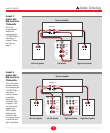
10
Model 272 PBM THX
Atlantic Technology
®
How Much is Enough?
Sometimes people prefer more bass impact for movies than sounds natural when reproducing music.
You may wish to determine both a video level and an audio level if you find yourself falling into this
camp. Remember however, the most common error people make when setting up their system is to
play the subwoofer (and surrounds) too loudly. Of course, the Home Theater Police will not arrest you
for this act. But should you desire the most accurate overall reproduction, a well balanced sound from
bass to highest treble is the best way to get it. Have fun. Experiment. Enjoy.
Dual Subwoofer Placement
When two subwoofers are used you may wish to
place them asymmetrically; that is, in slightly
different positions in the room (Figure 5). This
will reduce common mode room resonances
that occur with symmetrically positioned sub-
woofers. You can also try placing the subwoofers
in the same corner, if you wish. Experiments
have shown this to be a viable means of produ-
cing smooth bass response in many rooms.
Using the Subwoofer Lo-Pass Control
When used with the complete System 270 THX, the 272 PBM THX Lo-pass control should be set at
80Hz unless you are using a processor with its own built-in crossover. The goal is to optimize the
performance of the system by ensuring that the subwoofer and satellites produce a cohesive and well
integrated sound “picture.” The low frequency response of the System 270 THX satellites has been
optimized to work with approximately an 80Hz crossover point.
Higher crossover frequencies pass more bass but can sound boomy and may be more easily localized to
the subwoofer. Higher crossover frequencies may be suitable, however, when using very small satellites
that have no real low frequency performance. Settings lower than 80Hz should be employed if you are
using larger speakers that have extended bass response. This way, the subwoofer will only reproduce
the very lowest bass frequencies that are in the range where the large main speakers begin to roll off.
It’s generally undesirable to have the main speakers and the subwoofer overlap too much. Larger
speakers means a lower Lo-pass crossover frequency, smaller speakers means a higher Lo-pass crossover
frequency. Consult the manufacturer’s specified low frequency response for your main speakers to
determine the appropriate Lo-pass setting on your subwoofer. In the end, however, a little time spent
experimenting will generally result in dramatically better bass response.
The Phase Invert Control
A subwoofer operating out of phase with the rest of the system won’t provide optimum low frequency
performance. Also, the correct subwoofer phase can enhance room acoustics. Since there is so much
variation in the industry regarding phase, and no standards have been established, a switch that will
reverse the phase of the subwoofer is provided on the amplifier panel. Listen to a monaural musical
source with strong bass content. (For example, you can use the mono switch on an FM tuner or
preamp, or use a Y-connector on the outputs of one of your source components to get a mono signal.)
Experiment with the position of the phase switch to get the most extended bass. It should be obvious
which is the correct setting. In particular, there will be a smoother more integrated transition between
the satellites and the subwoofer when they are properly phased.
Figure 5:
Assymmetrical
arrangement for
2 subwoofers in
a home theater,
for example, one
closer to a corner
than the other














